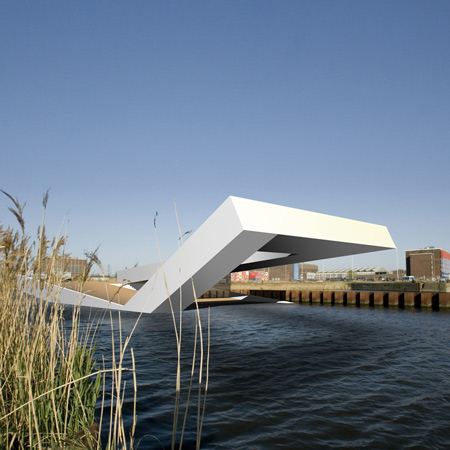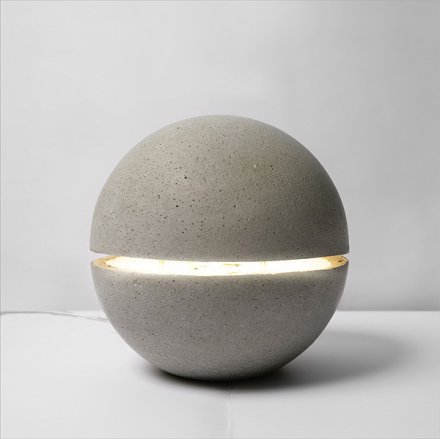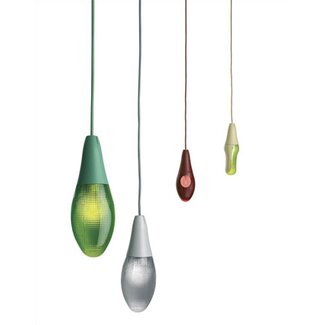O+A
is based in Amsterdam on the former NDSM shipyard. It holds office in
the front office of the Shipbuilding Warehouse with a spectacular view
over the river IJ.
The studio is easily reached from Amsterdam
Central Station using the free ferry service. The ferry leaves 15
minutes before and 15 minutes after each hour, taking approximately 15
minutes to get to the NDSM. A second ferry service leaves from the
Houthavens with an irregular schedule. Please check the GVB's
website for further details.
Should you come by car, parking spots are numerous and free of charge.
Today's Elixir Fix is O+A Strategies & Architecture, based in Amsterdam. Founded by . Auguste van Oppen and Marc van Asseldonk partnered for a design in the Eurpan 9 entry where they won first prize and wisely continued their partnership and opened O+A. The awards and praises have not stopped coming.
Here are a few of my favorite projects from minds of O+A (built and conceptual). Visit the links to read up on the full project descriptions.
Project | O+A's Studio, Their office is in a former Shipbuilding Warehouse!
Location | NSDM Shipyard, Amsterdam, The Netherlands
awards
- 2008: first prize Europan 9
- 2007: nomination Archiprix 2007
exhibitions
- 1/2010: 20 years Europan in The Netherlands, NAi Rotterdam (NL)
- 9/2008: Europan exhibition, lecture and debate, Arcam Amsterdam (NL)
- 5/2008: Europan 9 Forum of Results, Palacio de Congresos Santiago de Compostela (ES)
- 4/2008: Europan 9 exhibition, NAi Rotterdam (NL)
- 6/2007: Archiprix 2007 exhibition, Las Palmas Rotterdam (NL)
press
awards
- 2008: first prize Europan 9
- 2007: nomination Archiprix 2007
exhibitions
- 1/2010: 20 years Europan in The Netherlands, NAi Rotterdam (NL)
- 9/2008: Europan exhibition, lecture and debate, Arcam Amsterdam (NL)
- 5/2008: Europan 9 Forum of Results, Palacio de Congresos Santiago de Compostela (ES)
- 4/2008: Europan 9 exhibition, NAi Rotterdam (NL)
- 6/2007: Archiprix 2007 exhibition, Las Palmas Rotterdam (NL)
press

Location | The IJ Estuary, Amsterdam
Year | 2009
Location | Auyksciai Forest, Lithuania
Year | 2011
Location | De Gaffel, Veldhoven
Structural Engineer | Van De Laar
Year | 2009
Location | Municipality of Enschede
Year | 2009
year: 2009
site: the IJ estuary, Amsterdam
commission type: unsolicited
team: Marc van Asseldonk, Auguste van Oppen
Aside
from acquiring projects through traditional means, O+A is attempting to
unfurl several initiatives of its own. One of these projects is the
urban beach in Amsterdam’s IJ estaury.
O+A sees the city as a
patchwork of meanings. On every corner of every street there is
something which has a special value for one or more individuals, for one
or more reasons. The history, the programme, the users, the events and
of course the architecture together play a role in the realisation of
this patchwork.
One of the most important issues in developing
real estate is the marketing aspect. Developers spend enormous amounts
of energy and money in marketing, in an attempt to create meaning for
something which does not yet exist. Using billboards, websites and
folders, images are portrayed with a predetermined image of happiness
for a predetermined target audience. Through initiating the floating
swimming pool in the IJ, O+A is attempting to create something which
will allow potential users to form their own image of a site, in a more
natural way. By combining public programme with a future building site,
city dwellers are enabled to familiarise themselves with a site whilst
being entertained. A developer is thus able to capitalise on an
investment while making a significant addition to the amenities of
Amsterdam.
The floating swimming pool is very interesting because
it touches upon so many aspects of the city. The municipality of
Amsterdam has initiated a major offensive concerning sustainability and
it has great ambitions therein. One of the milestones in this endeavour
is Amsterdam Waterstad (watercity) 2010. Several initiatives are being
undertaken which should place Amsterdam on the map in terms of
sustainability and water. In that light, the image of people swimming in
the IJ would be a testament to the water quality in this city. Parallel
to this discussion, national politicians are calling for more urban
swimming locations. In short, the floating swimming pool has the
potential to charm citizens, enterprises and governments alike.
For
the design, a swimming pool has been taken with sufficient surrounding
public space. This basic typology is folded to make the object more
flexible. This way an open-air movie theatre can also be held in the
summer and a wellness centre can also be held in the winter. The
inclined surface presents itself as an urban beach which does no more
than provide access to the IJ along Amsterdam’s rigid quaysides. The
clear form in which all of this happens, works as a framework in which
the variation of programme and users is encouraged.
year: 2009
site: the IJ estuary, Amsterdam
commission type: unsolicited
team: Marc van Asseldonk, Auguste van Oppen
Aside
from acquiring projects through traditional means, O+A is attempting to
unfurl several initiatives of its own. One of these projects is the
urban beach in Amsterdam’s IJ estaury.
O+A sees the city as a
patchwork of meanings. On every corner of every street there is
something which has a special value for one or more individuals, for one
or more reasons. The history, the programme, the users, the events and
of course the architecture together play a role in the realisation of
this patchwork.
One of the most important issues in developing
real estate is the marketing aspect. Developers spend enormous amounts
of energy and money in marketing, in an attempt to create meaning for
something which does not yet exist. Using billboards, websites and
folders, images are portrayed with a predetermined image of happiness
for a predetermined target audience. Through initiating the floating
swimming pool in the IJ, O+A is attempting to create something which
will allow potential users to form their own image of a site, in a more
natural way. By combining public programme with a future building site,
city dwellers are enabled to familiarise themselves with a site whilst
being entertained. A developer is thus able to capitalise on an
investment while making a significant addition to the amenities of
Amsterdam.
The floating swimming pool is very interesting because
it touches upon so many aspects of the city. The municipality of
Amsterdam has initiated a major offensive concerning sustainability and
it has great ambitions therein. One of the milestones in this endeavour
is Amsterdam Waterstad (watercity) 2010. Several initiatives are being
undertaken which should place Amsterdam on the map in terms of
sustainability and water. In that light, the image of people swimming in
the IJ would be a testament to the water quality in this city. Parallel
to this discussion, national politicians are calling for more urban
swimming locations. In short, the floating swimming pool has the
potential to charm citizens, enterprises and governments alike.
For
the design, a swimming pool has been taken with sufficient surrounding
public space. This basic typology is folded to make the object more
flexible. This way an open-air movie theatre can also be held in the
summer and a wellness centre can also be held in the winter. The
inclined surface presents itself as an urban beach which does no more
than provide access to the IJ along Amsterdam’s rigid quaysides. The
clear form in which all of this happens, works as a framework in which
the variation of programme and users is encouraged.
year: 2009
site: the IJ estuary, Amsterdam
commission type: unsolicited
team: Marc van Asseldonk, Auguste van Oppen
Aside
from acquiring projects through traditional means, O+A is attempting to
unfurl several initiatives of its own. One of these projects is the
urban beach in Amsterdam’s IJ estaury.
O+A sees the city as a
patchwork of meanings. On every corner of every street there is
something which has a special value for one or more individuals, for one
or more reasons. The history, the programme, the users, the events and
of course the architecture together play a role in the realisation of
this patchwork.
One of the most important issues in developing
real estate is the marketing aspect. Developers spend enormous amounts
of energy and money in marketing, in an attempt to create meaning for
something which does not yet exist. Using billboards, websites and
folders, images are portrayed with a predetermined image of happiness
for a predetermined target audience. Through initiating the floating
swimming pool in the IJ, O+A is attempting to create something which
will allow potential users to form their own image of a site, in a more
natural way. By combining public programme with a future building site,
city dwellers are enabled to familiarise themselves with a site whilst
being entertained. A developer is thus able to capitalise on an
investment while making a significant addition to the amenities of
Amsterdam.
The floating swimming pool is very interesting because
it touches upon so many aspects of the city. The municipality of
Amsterdam has initiated a major offensive concerning sustainability and
it has great ambitions therein. One of the milestones in this endeavour
is Amsterdam Waterstad (watercity) 2010. Several initiatives are being
undertaken which should place Amsterdam on the map in terms of
sustainability and water. In that light, the image of people swimming in
the IJ would be a testament to the water quality in this city. Parallel
to this discussion, national politicians are calling for more urban
swimming locations. In short, the floating swimming pool has the
potential to charm citizens, enterprises and governments alike.
For
the design, a swimming pool has been taken with sufficient surrounding
public space. This basic typology is folded to make the object more
flexible. This way an open-air movie theatre can also be held in the
summer and a wellness centre can also be held in the winter. The
inclined surface presents itself as an urban beach which does no more
than provide access to the IJ along Amsterdam’s rigid quaysides. The
clear form in which all of this happens, works as a framework in which
the variation of programme and users is encouraged.






















